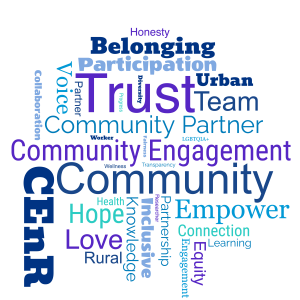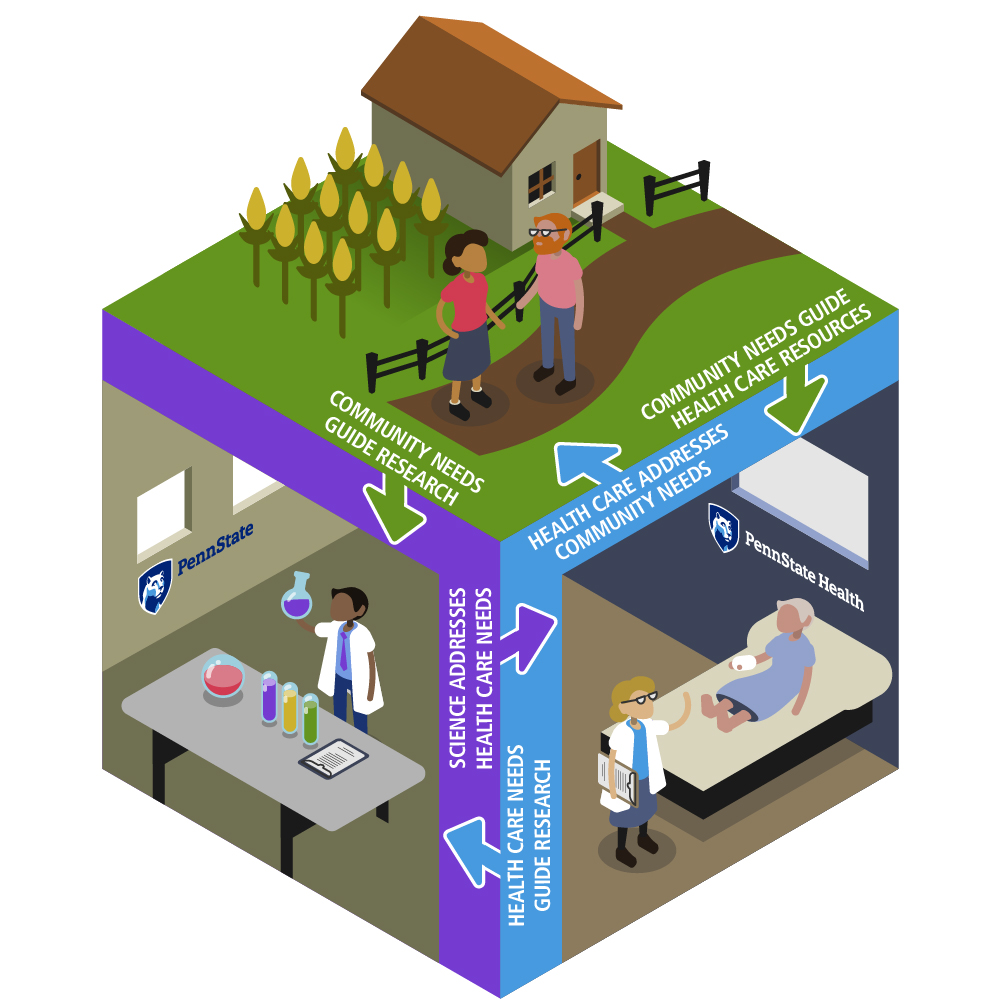Jump to topic
Search
Research Basics

Are you new to research as a community partner? Let’s start by covering some important terms to help guide your understanding of how community engagement fits into the big picture of research.
First off, what is research?
The purpose of research is to learn new information beyond what is already known.1 There are several different types of research studies that can include humans, animals, plants, and other organisms.1 For the purposes of this toolkit, we’ll be discussing research that involves human participants (also called human subjects research).
Research can be performed by many different organizations, such as academic institutions, healthcare and medical facilities, businesses, community-based organizations and government agencies.3 Depending on the group conducting the research, study goals may include advancing our understanding of human behavior and cultures, evaluating the effectiveness of medical treatments, answering why something is happening (cause and effect relationships), improving community conditions, assessing marketing strategies, and/or identifying historical patterns.

In general, research projects are designed according to a series of stages, starting with identifying a problem or issue and ending with study findings being shared and a call-to-action.
Let’s Define It!
Research: A scientific method to discover new knowledge.1
Research studies usually start with a research question. There are several methods researchers use to try to answer a research question, which may include:
- Interviewing people one-on-one or in a group setting (focus group) to learn about their experiences and/or perspectives
- Asking people to complete a survey, either in-person or online
- Providing patients with medications, devices, or behavioral changes (such as increased exercise or eating healthier)
- Collecting scientific samples (such as blood or urine) for analysis and experiments
- Looking at and combining data that others have collected4
The CHEER team recognizes that the term research can mean different things for different people and communities. For some, it might represent hope. For some, it might represent fear. Please see Section 4, which discusses the historical and inhumane treatment of research participants and details the current regulations in place to protect human subjects.
Without getting to know a community and listening to its members, researchers may miss important information. For example, if a researcher is conducting a study to see if providing vouchers to cover the costs of fruits and vegetables at farmers markets increases healthy eating to improve diabetes, it is important to learn about the community first. Without knowing the community and working with its members, researchers may miss important information. In this situation, if the local community members with diabetes don’t have a lot of experience preparing the fruits and vegetables available to them or an easy way to get to the farmers markets due to a lack of transportation, then the day-to-day experiences of the community will not line up with the study, and the results won’t be helpful. A failure to consider the unique needs and challenges faced by the community under study can interfere with research findings and limit their potential benefits for people.5
 So how can we make sure that research studies match the needs of patients and other members of the community that we are trying to help? You guessed it! By researchers seeking input from community members, like yourself, who have a true understanding of real barriers within the communities they serve.6 This approach is known as community-engaged research (CEnR).
So how can we make sure that research studies match the needs of patients and other members of the community that we are trying to help? You guessed it! By researchers seeking input from community members, like yourself, who have a true understanding of real barriers within the communities they serve.6 This approach is known as community-engaged research (CEnR).
Let’s Define It!
Community-engaged research: Community members and researchers working together during a research study to address issues affecting the well-being of the people in the community.7
So how is community-engaged research different from traditional research?
In traditional research, the researcher designs a study and performs the research on the community, typically by recruiting patients or other members of a community to participate in the study that the researcher has developed. In community-engaged research, the researcher partners with the community to develop and conduct the research through shared decision-making throughout the research process.8
The involvement of the community in research is a powerful way to bring about environmental, social, and behavioral changes to improve overall well-being.9 CEnR is being recognized more and more as an important way to share research results back to communities.10,11
Let’s Define It!
Translation: The process of turning study results into helpful practices or policies to improve the health of community members.12

Members of a CEnR team

It takes a village! For CEnR to work best, a group of individuals work in partnership toward the same goals. Community partners bring an important voice to the research project and may point out areas of interest or concern that may not have been previously thought about by researchers. Connecting the community to the research project opens it up to help more people by shifting the focus from one person to the entire group. This allows for more inclusion of the cultural values, diversity of interests, and perspectives that exist within a specific community to impact the research, thus making it more helpful to everyone.9
Typically, the main members of a research study include:
A Researcher or Academic Partner – Individual researchers and their teams, as well as research organizations. Researchers are often connected to a hospital, academic medical center, college or university, and/or another organization:
- Principal investigator (PI): Lead researcher for a study; assumes full responsibility for study.
- Co-investigator(s): A researcher who contributes significantly to a study.
- Project manager(s): A research team member who manages a research study and oversees research staff.
- Project coordinator/human research technologist(s): A research team member who coordinates day-to-day study operations.
Conducting any research study, including CEnR, often involves collaboration with other research support services, such as individuals who assist in the proposal submission process, those that help manage your research budget, data managers and statisticians to assist with data collection and analysis, among others!
A Community Partner – Individuals (such as patients, caregivers, clinicians, policy makers, educators, and other community members) or organizations (such as community groups and human service agencies specializing in housing, employment, food security and education, clinics, health departments, advocacy groups, faith-based organizations, small businesses, and other groups representing communities and cultures) who share their voices, perspectives, and knowledge to help with research. ‘Stakeholder’ is another term to describe community partners.13,14
Did You Know?
Wondering what’s the difference between a community partner and a research participant? A community partner serves as an equal partner on the research team and assists in study decision-making. They can help drive the direction of the research through their expertise or lived experience. A research participant is someone who provides their informed consent to participate in the research study and complete study visits/procedures. Sometimes, we have community partners who have participated in research studies in the past as participants. Both experiences help shape the research and move it in the right direction!
- External community partner team may include:
- Advocate
- Clinic, hospital, health system representative
- Clinician
- Community-based organization representative (CBO)
- Community health worker (CHW)
- Community member educator/school administration (K-12)
- Higher education representative
- Industry representative
- Law enforcement officer
- Parent/guardian
- Patient/caregiver
- Payer (public or private insurance) representative
- Policy maker (government official)
- Religious leader
- Research volunteer
- Social worker
- Subject matter expert
- Among others!
Did You Know?
Community Health Workers (CHWs) can be a very important part of a research team! CHWs are public health workers who are trusted members of the community and are close with the people they serve. Because of the special roles CHWs have in their communities, they are able to connect health services and research back to the community.
Check out how CHWs partnered with the Penn State Racial and Ethnic Approaches to Community Health (REACH) Project to best serve Hispanic and Latino populations in Pennsylvania communities during the COVID-19 pandemic.
Interested in learning how to become a Certified Community Health Worker (CCHW) in Pennsylvania? Go to the PA Certification Board website for everything you need to know!
Are you connected with a CHW interested in engaging in research at Penn State? Contact CHEER to learn more: CHEER@pennstatehealth.psu.edu
Community Engaged Research (CEnR) as a Continuum
Every CEnR project is unique, and the involvement of a community partner in a study can range from a little to a lot.15-17 Some projects may include a small amount of involvement, such as reviewing and giving feedback about the study’s ideas for helping the community. Other projects may include much more involvement during important phases of the research, including determining the problem to be studied, conducting the research, and sharing the study results. Some community partners may be engaged in a research study at varying levels over the course of the project. For example, a research team may be partnering with a local agency that helps to decide the research goals at the beginning of the project but isn’t actively involved again until near the end when sharing the results of the study with community members.18
“Community involvement in all phases of research can help to ensure that new treatments and health discoveries are more effective and meaningful for the people they are intended to reach.”
– Andrea Murray, Project Director, REACH
Stages of Research
Research follows a series of stages. Not every project has all of these, but they generally follow along these lines.
Reproduced with permission: Research: What’s Community Got to Do with It? Toolkit for Community Organizations Interested in Research. (2019). Center for Clinical and Translational Science, University of Illinois at Chicago. Retrieved from http://www.ccts.uic.edu/content/target-populations-toolkit.
Importance and benefits of CEnR
Regardless of the amount of involvement in a CEnR project, community partners offer inside understanding and knowledge of the community and culture that may otherwise be overlooked by an outside researcher.19 This important information improves the outcomes of the research project and makes study findings more likely to be helpful to many more people.
Did You Know?
Many research grants offer sub-awards that provide salary support for additional staffing needs of community-based organizations that are interested in partnering in CEnR projects. If you are interested in learning about these opportunities, the CHEER team is here to help you discover grants that are good matches for helping the community while meeting the needs of your work team!
A research project lifecycle graphic including all stages of a research project: What is/are the research question(s); Time to write up the idea; Submit for funding; Receive funding (hopefully!); Get approval to start the research project; Collect data; What did we find? Let’s analyze it; What do the results mean? Let’s translate; Who will this research impact? Share findings; Call to action.
Three faces of a cube portray the interactions and influences between communities, scientists and health care professionals. On the top face is a community graphic which shows two citizens engaged in a conversation on a roadway outside a rural dwelling attached to a farm. On the front left face is a scientist in a lab wearing a lab coat and holding a vial of liquid. In front of them is a table with a clip board and more vials of liquid. The Penn State logo is visible on the wall underneath two windows. On the front right face is a patient and doctor conversing in an exam room. The doctor, wearing a lab coat, holds a clipboard while the patient, dressed in an exam gown, is lying on a bed with a cast on their right arm. The Penn State Health logo is visible on the wall underneath a single window. Various arrows show how the various groups influence each other. An arrow pointing from the community face to the science face says community needs guide research. An arrow pointing from the science face to the health care face says science addresses health care needs. An arrow pointing from the health care face to the science face says health care needs guide research. An arrow pointing from the health care face to the community face says health care addresses community needs. An arrow pointing from the community face to the health care face says community needs guide health care resources.
The continuum flows in the following order:
- Inform: Researchers share information with community
- Consult: Researchers seek feedback from community on aspects of research (e.g., study aims, procedures)
- Participate: Community is involved in key phases of research (e.g., recruitment, data collection)
- Initiate: Community brings gap/problem to researchers to address together
- Lead: Community leads decision-making for research
Inform, consult and participate are part of a collaboration phase, where community-academic partnerships are formed and research is responsive to community needs.
Participate, initiate and lead are power of an empowerment phase, where community-driven research with strong academic partnerships leads to broader community health outcome impact.
The earlier steps in the process involve unidirectional communication, while later the process leads to bidirectional communication.

